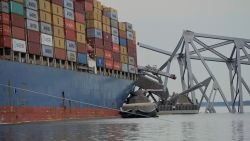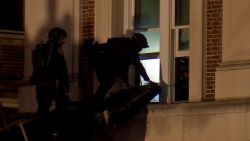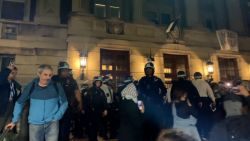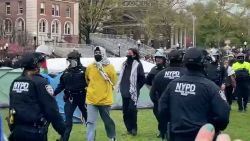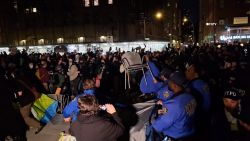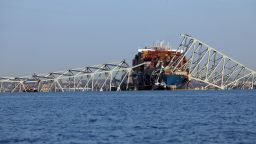Crews are working to remove the first portion of Baltimore bridge wreckage – the starting point in a complicated, extensive cleanup process that could help open up a temporary channel to get more vessels into the water around the collapse site, officials said.
Clearing the channel will allow the search for the missing victims to continue and reopen a port critical to the local and national economies, authorities said Saturday. In the meantime, conditions in the water make it unsafe for divers as pieces of the bridge remain submerged in the water.
“At this time, pieces of the bridge trusses have started being cut and removed,” US Coast Guard spokesperson Petty Officer Kimberly Reaves said Sunday. “The top part of a northern section of the bridge has been removed.”
A 213-million-pound cargo vessel slammed into the Francis Scott Key Bridge last week, killing six construction workers. The bodies of four victims have yet to be recovered. They are trapped in the tangle of steel and concrete underwater, authorities believe.
“We have a ship that is nearly the size of the Eiffel Tower that is now stuck within the channel that has the Key Bridge sitting on top of it,” Maryland Gov. Wes Moore said Sunday CNN’s “State of the Union.”
Officials don’t yet have a timeline for reopening the channel or rebuilding the bridge, Secretary of Transportation Pete Buttigieg said Sunday on CBS’s “Face the Nation.”
Buttigieg said a 1,000-ton capacity lift crane is on site and a 600-ton crane is on its way to help remove dismantled pieces of the bridge.
“This is going to be a very complex process,” he said. “There are, even now, forces acting on that steel, so it takes a lot to make sure that it can be dismantled safely, to make sure that the vessel stays where it is supposed to be and doesn’t swing out into the channel.”
Officials at the site of the bridge collapse told CNN they are doing engineering analysis and surveys to determine how to tackle the 3,000 to 4,000 tons of mangled wreckage that extends 50 feet deep into the channel.
Removing the thousands of tons of steel and concrete resting atop the vessel’s bow will be one of the most intricate parts of the dismantling operation, officials say.
The wreckage will be lifted one piece at a time. After each lift, responders will scan and survey the area and divers will go in the water, US Army Corps of Engineers Commander and District Engineer Estee Pinchasin told CNN.
“We are not just looking at how we’re going to engineer this,” Pinchasin said. “We’re scanning to make sure that if we identify any vehicles or any of the fallen, that we are able to react.”
Divers from the Maryland State Police are on a “hot standby,” Pinchasin added, ready to handle any recovery quickly.
The work will allow for the opening of a temporary restricted channel for vessels to move into the area and assist with recovery, Moore said Saturday.
The temporary channel will allow commercially essential vessels to access the port and “mark an important first step along the road to reopening the port of Baltimore,” Capt. David O’Connell, federal on-scene coordinator for the bridge collapse response, said in a news release Sunday.
The temporary channel will be on the northeast side of the main channel and will be marked with government lighted aids to navigations when it opens, the release said.
The economic impact of the bridge collapse could be wide-ranging, as it has indefinitely halted the flow of ships in and out of the Port of Baltimore and delivered a stunning blow to the thousands of dock workers who rely on the busy port.
“People have to remember this is not a Baltimore catastrophe, not a Maryland catastrophe,” Moore said Sunday. “This is a national economic catastrophe as well.”
The first debris lift marks the beginning of a long process toward reopening the port to tug and barge traffic, Rear Adm. Shannon Gilreath of the US Coast Guard said at the Saturday news conference. “Much like when you run a marathon, you’ve got to take the first few steps,” he added.
“If we can open up another (channel) that will help the economy here and move traffic in and out of the port of Baltimore, even if it’s not the deep draft, we wanna take advantage of that opportunity.” Gilreath said.
The port “handles more cars and more farm equipment more than any other port inside this country,” the governor said. Plus, “at least 8,000 workers on the docks have jobs that have been directly affected” by the collapse.
Rebuilding the bridge will take longer, Buttigieg said Sunday.
“I can tell you the original bridge took about five years to build, but that doesn’t necessarily inform us about the timeline on the reconstruction,” he said. “We don’t fully know everything we need to know about the condition of the portions of the bridge that did not collapse.”
The work is currently being funded through $60 million in emergency relief funds through the Department of Transportation, Buttigieg said, adding officials may need to turn to Congress to supplement the funding.
Small businesses affected by the collapse can apply for loans of up to $2 million, supported in part by a disaster declaration approved by the Biden administration, Moore announced Saturday.
After the initial lift takes place, “there still needs to be an understanding of what forms of adjustments have happened,” the governor said.
In order to reopen the port, the Coast Guard says it will first clear debris from the deep draft channel, remove the ship, then clear debris from the bridge across the waterway.
“We are continuing to do diving just for the purposes of evaluating how we can actually potentially cut up portions of the bridge, how we can rig for future lifts with the cranes and how we can figure out exactly how to do this as safely as possible so that we can get that channel reopened,” Gilreath said Saturday.
On Sunday, CNN crews followed the vessel’s original path before the crash and observed an untouched piece of the Key Bridge’s roadway that collapsed on top of the ship’s bow early last Tuesday.
Among the wreckage were hundreds of still-stacked shipping containers, some crushed together, while a few others teetered on the vessel’s edge.
Ongoing cleanup efforts have included isolating a section of an underwater natural gas pipeline, the Baltimore Gas and Electric Company told CNN in an email Saturday.
A spokesperson said the company has “intentionally released gas from that section as a proactive safety measure in support of the salvage operations” near the bridge. The work has not resulted in customer impacts or safety concerns, according to the spokesperson.
The crew of the cargo ship that hit the bridge remained on the ship Sunday, a Coast Guard official said.
The ship was on a planned 45-day trip to Sri Lanka and the crew was supplied with enough materials, Coast Guard Capt. David O’Connell told CNN during a boat ride to the scene of the collapse on Sunday. The crew’s living quarters are undamaged, according to O’Connell.
“They’re holding up well,” he said of the ship’s crew of 21 Indian nationals. “They were in a, you know, a pretty horrific accident,” O’Connell said. “We can’t lose sight of the tragedy, the human element of that.”
Divers could face uncertain conditions when they return to the water
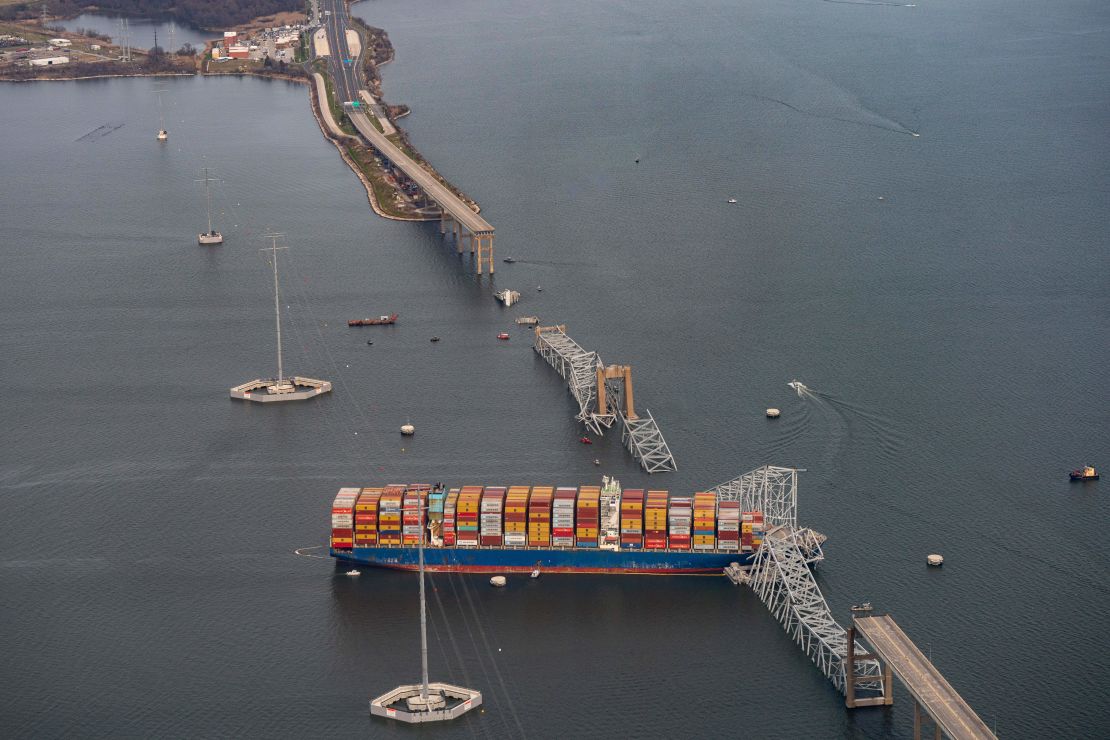
Diving operations were paused for the four missing victims because vehicles were found encased in concrete and other debris, making it unsafe for divers, Col. Roland L. Butler said last week.
After search efforts were halted, remote vehicles were sent down with sonar that plotted what exactly fell deep into the Patapsco River after the collapse, Butler said Wednesday. Drones and infrared technology were also used as part of the search.
Once salvage operations clear the debris, divers resuming the search for the victims could be faced with a difficult task, according to Mark Martin of marine survey and salvage company at SalvOcean LLC.
“The current there is quite fast and having spent a number of days submerged in Baltimore Harbor, I can tell you that you can never see more than one or two feet in front of your face,” Martin told CNN Saturday.
Still, the current isn’t heavy enough to shift larger pieces of debris, Martin said.
“Once those things start getting cut up, then you have to be careful, you’re gonna have to monitor the current, the direction, the speed, all of those things,” he said.
Sonar is typically continually monitoring any movement of the ship. With the amount of weight on the bow of the ship, Martin said he believes the only movement could be the bow sinking deeper into the sand than it already is.
CNN’s Michelle Watson, Lauren Mascarenhas, Steve Williams and Sarah Dewberry contributed to this report.



